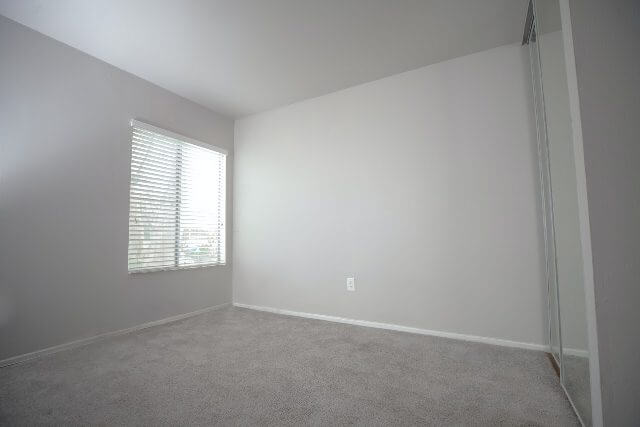In this article, we shall look into different ways on how to remove glued down carpet pad from concrete.

It is not unusual for a carpet pad to stick to the floor due to the carpet adhesive applied to make it stay in place during installation.
Trying to pull it off often leaves a residue that is challenging and very frustrating to remove.
Whether you are doing a home makeover or simply changing the carpet pad, you can remove the stuck pad and reside by following the steps below
Steps on how to remove glued down carpet pad from concrete
These are the following steps that you must follow if you want to remove glued down carpet pad from concrete:
Step 1: Scrape the floor using a floor scraper/utility knife
Step 2: Soften the glued padding using hot water or mineral spirit
Step 3: Scrape the carpet padding residue
Step 4: Warm soapy water and a concrete brush
Step 5: Apply glue remover and scrub
Step 1: Scrape the floor using a floor scraper/utility knife
You will need a few tools to remove the carpet pad stuck on the cement floor.
One of these tools is a floor scraper. You can use a utility knife but for easier and faster results, a floor scraper is more appropriate.
If you do not have a floor scraper or the funds to buy one, you can rent from your nearest home improvement store.

A floor scraper will help to remove large pieces of the top layer of the glue padding.
The scrapping process will not be easy so you require hand gloves and knee pads to protect yourself from injuries and pain.
Also, a face mask is necessary because you will encounter dust, pieces of disintegrated carpet pad, and sometimes mold during the scrapping process.
If you suffer from asthma or allergic reactions, it is not advisable to do the scrapping. Remember to keep the doors and windows of the room open for maximum ventilation.
Start by scrapping the carpet padding at an angle and take care not to damage the underneath floor.
While this process might not remove all the padding, it is a good starting point.
After you are satisfied that you have scraped as much of the padding as possible, sweep away the large chunks and move to step two.
Step 2: Soften the glued padding using hot water or mineral spirit
The glued-down padding will need to be softened in order to come off easily.
You can do this using hot water or mineral spirit.
I would recommend using mineral spirit if you are removing the padding on a small area because it is expensive.
Otherwise, hot water will serve a similar purpose and it’s readily available and free of toxic chemicals.

All you need to do is boiling enough water to cover the padding on the concrete floor.
Remember to protect yourself first by wearing hand gloves and work boots so that you do not burn your feet.
When pouring water on the floor, lower the pot with hot water really low and pour slowly to avoid splashing on yourself. The last thing you want is to come out with burns.
Pour hot water all over the floor and give it around ten minutes to soften.
Instead of pouring the hot water directly on the padding, you can as well place a towel on the floor, pour hot water on it, and let sit for about 30 minutes.
If you prefer to use mineral spirit to soften the carpet padding, apply it to different sections and let it sit for 30 minutes before scrapping. The only downside with using mineral spirits is that it will take you longer because the waiting time is more.
See also: How to Keep a Rug in Place on Carpet
Step 3: Scrape the carpet padding residue
After the padding softens, you need to quickly start scrapping the stuck residue before it cools off.
Use a floor scraper to remove the pad residue in sections.
If you still notice persistent glue patches, pour more hot water, and repeat the scrapping. However, if this fails to work, move to the next step.
Step 4: Warm soapy water and a concrete brush
It’s time to use a little elbow grease to remove the remaining pad residue.
Mix soap (preferably Murphy’s soap) with warm water. Soak a rag in the solution and wipe the floor.
After soaking, use a concrete brush to scrub off the carpet padding.
Wipe out the scrubbed section and if there is still glue, repeat the process until it is clean or most of the paddings are removed.
See also: What not to use magic eraser on
Step 5: Apply glue remover and scrub
If you did not manage to remove all the glue padding with the murphy soap and concrete brush, it is time to try glue remover as shown in the video below.
Carpet adhesive removers are meant to soften the glue for easy removal.
However, adhesive removers can be hazardous so it is advisable to pick one that is not harmful. Try this 626 adhesive remover that is not only non-hazardous but also non-flammable and has a low odor.
It is quite effective in removing adhesive, acrylic, and latex from terrazzo, concrete, vinyl tile, wood, and even ceramic floors.
Take time to read the guidelines and warnings on the package of the glue remover before using it. If you have underlying respiratory health issues, you might want to skip using these chemicals or assign the duty to someone else. Also, ensure doors and windows are open for maximum ventilation.
After applying the glue remover, the padding will soften and become loose. Using a floor cleaner of your choice, thoroughly work on your floor. Rinse it with warm water and leave it to dry before installing the next type of flooring.
See also: Do carpet pads ruin hardwood floors?
Conclusion
If you have been wondering how to remove glued down carpet pad from concrete, the steps above should be of great help. Removing carpet padding is not easy, but that should not stop you from renovating your floor.
One or a combination of the steps above should work for you. If step one is not effective, combine it with steps two and four for effective results.
Patience and the necessary safety precautions must be applied to achieve the desired results.
However, if you do not get the desired results from the steps above, it is time to consult and hire a professional.
